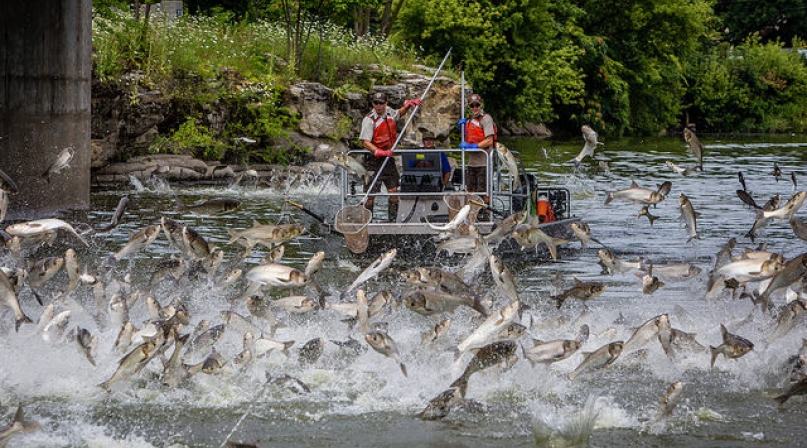‘Wall of sound’ helps corral 47,000 Asian carp; invasive species overran Missouri county lake

St. Louis County scared invasive fish out of a lake with the sound of motorboats
Rounding up 47,000 fish in a 320-acre lake in a Missouri county took some ingenuity, using a method that has been used in Asia but not often in the United States.
The Missouri Department of Conservation, which manages Creve Coeur Lake, approached St. Louis County late last summer about helping it rid the lake of some 119 tons of invasive Asian carp.
“You have all this recreational use of the lake and then you get these fish that jump out of the water and they can injure people,” said Tom Ott, assistant director of the St. Louis County, Mo. Department of Parks and Recreation.
The Asian silver carp is especially skittish and easily startled and can jump as high as 10 feet out of the water.
A YouTube video, “Creve Coeur Lake Asian carp” taken by a Washington University student, shows “kids that were in their rowing boats as they were coming back from the dock and these fish start jumping out of the water, hundreds of them,” Ott said. “And this was probably about four years ago.”
Ott said he, too, has seen Asian carp jumping out of the water while on the Mississippi River.
In addition to possibly slapping boaters in the head, the fish is considered a nuisance because it consumes all the plankton and other organisms that native crappie normally eat. Asian carp eat 5 percent to 20 percent of their body weight each day and can grow to be more than 7 feet long and weigh more than 100 pounds.
The invasive species, (primarily bighead carp and silver carp), were imported into the United States from Southeast Asia as a way to clean fish farms and wastewater treatment facilities.
But flooding allowed them to escape to the Mississippi and Missouri rivers, and experts have been stymied ever since, trying to get rid of them, mainly in waterways in Missouri and Illinois. They got into St. Louis County as early as 2009 from several floods, Ott said.
Getting rid of them isn’t easy. Asian carp hate the sound of motorboat motors, so conservationists isolated the sound and broadcast it underwater in St. Louis County, using the noise to herd the fish to one end of Creve Coeur Park Lake, where they were removed. Wintertime was the best time because the fish don’t jump around as much in colder temperatures. In addition to broadcasting the sound of motorboat motors, they also used nets, ultrasound and electric shocks to herd the fish.
“This is still a new type method of removing these carp from the lakes, it’s called the Unified Method,” Ott said.
The fish were carted away to a landfill. Wildlife code doesn’t currently permit them to use the fish for other purposes, Ott noted.
The county Parks and Recreation Department helped the state department of conservation, the U.S. Geological Survey and the U.S. Fish and Wildlife Service. The Unified Method got rid of about 85 percent to 90 percent of the fish in the lake.
“Getting these fish out of the lake,” Ott said, “will allow the crappie and other native species to bounce back.”
Attachments
Related News
‘Fix-It Fair’ brings new life to damaged items, helps divert waste
Thurston County, Wash. partnered with a non-profit, whose members volunteer to fix things that were difficult to recycle.

U.S. House of Representatives passes SPEED Act and other permitting reform bills
On December 18, the U.S. House of Representatives passed the SPEED Act (H.R. 4776). The SPEED Act would strengthen county involvement in decision-making and make needed commonsense reforms to the federal environmental review process.

House Natural Resources Committee advances the Endangered Species Act Amendments Act of 2025
On December 17, the House Natural Resources Committee advanced the Endangered Species Act (ESA) Amendments Act of 2025 (H.R. 1897). The version passed by the committee adopted several changes from the initial bill and would address key county concerns by improving the implementation of the ESA. The legislation now awaits a floor vote before the whole U.S. House of Representatives.
